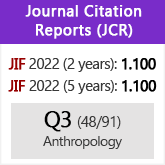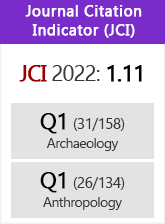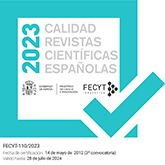Function and significance of bell beaker pottery according to data from residue analyses
DOI:
https://doi.org/10.3989/tp.2006.v63.i1.5Keywords:
Bell Beakers, Residue analysis, TransformationAbstract
Traditionally, Bell Beakers have been thought to contain alcoholic beverages which were consumed in the course of male feasting ceremonies. Recent residue analyses have shed some light on the question of their function. However, whilst beer and mead have been identified from certain examples, not all Beakers were drinking cups. Some were used as reduction pots to smelt copper ores, others have some organic residues associated with food, and still others were employed as funerary urns. Yet, while the evidence points to a diversity of uses, it is argued that an ideological connection can be observed. Beakers were probably a special form of pottery with a ritual character, related to activities that imply some kind of transformation.
Downloads
References
Alcalde, G.; Molist, M.; Saña, M. y Toledo, A. (eds.) 2001: “La Bauma del Serrat del Pont (Catalogne, Espagne). Un habitat campaniforme à production métallurgique”. En F. Nicolis (ed.): Bell Beakers Today. Pottery, People, Culture, Symbols in Prehistoric Europe. Proceedings of the International Colloquium Riva del Garda (Trento, Italy). 11-16 May 1998, II. Ufficio Beni Archeologici. Trento: 707-710.
Alcalde, G.; Molist, M.; Montero, I.; Planaguma, L.; Saña, M. y Toledo, A. 1998: “Producciones metalúrgicas en el noroeste de la Península Ibérica durante el III milenio cal AC: el taller de la Bruma del Serrat del Pont (Tortellà, Girona)”. Trabajos de Prehistoria 55 (1): 81-100.
Almagro Gorbea, M. y Collado, O. 1981: “La Loma de las Tejerías. Un asentamiento minero campaniforme en Albarracín (Teruel)”. Teruel 66: 87-105.
Balado Pachón, A. 1989: Excavaciones en Almenara de Adaja: El poblamiento prehistórico. Excma. Diputación Provincial de Valladolid. Valladolid.
Barandiarán, I. 1975: “Revisión estratigráfica de la Cueva de la Mora (Somáen, Soria), 1968”. Noticiario Arqueológico Hispánico, Prehistoria 3: 9-71.
Barclay, A. y Halpin, C. 1999: Excavations at Barrow Hills, Radley, Oxfordshire. Volume I: The Neolithic and Bronze Age Monument Complex. Thames Valley Lanscapes 11. Oxford Archaeological Unit. Oxford.
Barker, G. y Gamble, C. 1985: “Beyond Domestication: A Strategy for Investigating the Process and Consequence of Social Complexity”. En G. Barker y C. Gamble (eds.): Beyond Domestication in Prehistoric Europe. Investigations in Subsistence Archaeology and Social Complexity. Academic Press. London: 1-31.
Boast, R. 1995: “Fine pots, pure pots, Beaker pots”. En I. Kinnes y G. Varndell (eds.): ´Unbaked Urns of Rudely Shape‘. Essays on British and Irish Pottery for Ian Longworth. Oxbow Monograph, 55. Oxford: 69-80.
Bradley, R. 1984: The social foundations of prehistoric Britain: Themes and variations in the archaeology of power. Longman. London.
Bradley, R. 2003a: “A Life Less Ordinary: The Ritualization of the Domestic Sphere in Later Prehistoric Europe”. Cambridge Archaeological Journal 13 (1): 5-23. doi:10.1017/S0959774303000015
Bradley, R. 2003b: “Enclosures, Monuments and the Ritualization of Domestic Life”. En S. Oliveira Jorge (coord.): Recintos Murados da Pré-História Recente. Facultade de Letras da Universidade do Porto-Centro de Estudos Arqueológicos das Universidades de Coimbra e Porto. Porto-Coimbra: 355-369.
Bradley, R. 2005. Ritual and Domestic Life in Prehistoric Europe. Routledge. London.
Budd, P. y Taylor, T. 1995: “The faerie smith meets the bronze industry: magic versus science in the interpretation of prehistoric metal-making”. World Archaeology 27 (1): 133-143.
Bueno Ramírez, P.; Balbín Behrmann, R. De y Barroso Bermejo, R. 2000: “Valle de las Higueras (Huecas, Toledo, España). Una necrópolis Ciempozuelos con cuevas artificiales al interior de la Península”. Estudos Pré-Históricos VIII: 49-80.
Bueno Ramírez, P.; Barroso Bermejo, R. y Balbín Behrmann, R. DE. 2005: “Ritual campaniforme, ritual colectivo: la necrópolis de cuevas artificiales de Valle de las Higueras (Huecas, Toledo)”. Trabajos de Prehistoria 62 (2): 67-90.
Bueno Ramírez, P.; Barroso Bermejo, R.; Balbín Behrmann, R. DE; Juan-Tresserras, J. y Matamala, J.C. e.p.: “Contextos para las bebidas alcohólicas en la Prehistoria Reciente del centro de la Península Ibérica: la Cuenca Interior del Tajo”. Actas del Congreso Internacional de la Cerveza en la Prehistoria y la Antigüedad (Barcelona, 3-5 octubre 2004). British Archaeological Reports, International Series. Archaeopress. Oxford.
Burgess, C. y Shennan, S. 1976: “The Beaker Phenomenon: Some Suggestions”. En C. Burgess y R. Miket (eds.): Settlement and Economy in the Third and Second Millenia B.C., British Archaeological Reports 33, Archaeopress. Oxford: 309-331.
Cardoso, J.L. 2001: “Le phénomène campaniforme dans les basses vallées du Tage et du Sado (Portugal)”. En F. Nicolis (ed.): Bell Beakers Today. Pottery, People, Culture, Symbols in Prehistoric Europe. Proceedings of the International Colloquium Riva del Garda (Trento, Italy). 11-16 May 1998, I. Ufficio Beni Archeologici. Trento: 139-154.
Case, H.J. 1995: “Beakers: Loosening a stereotype”. En I. Kinnes y G. Varndell (eds.): ´Unbaked Urns of Rudely Shape‘. Essays on British and Irish Pottery for Ian Longworth. Oxbow Monograph 55. Oxford: 55-67.
Clarke, D.L. 1976: “The Beaker network: Social and economic models”. En J.N. Lanting y J.D. van der Waals (eds.): Glockenbechersymposion (Oberried 1974). Bussum. Haarlem: 460-477.
Cree, J.E. 1908: “Notice of a prehistoric kitchen midden and superimposed medieval stone floor found at Tusculum, North Berwick”. Proceedings of the Society of Antiquaries of Scotland XLII: 253-294.
Curwen, E.C. 1937: The Archaeology of Sussex. Methuen. London.
Davidson, C.B. 1869: “Notice of further stones kists found at Broomend near the Inverurie Paper-Mills”. Proceedings of the Society of Antiquaries of Scotland VII: 115-118.
Davis, S. y Payne, S. 1993: “A barrow full of cattle skulls”. Antiquity 67 (254): 12-22.
Delibes De Castro, G. 1977: El Vaso Campaniforme en la Meseta Norte Española. Universidad de Valladolid. Valladolid.
Delibes De Castro, G. 1995: “Ávila, del Neolítico al Bronce”. En M. Mariné (ed. lit.): Historia de Ávila. I: Prehistoria e Historia Antigua. Institución “Gran Duque de Alba” de la Excma. Diputación de Ávila-Caja de Ahorros de Ávila. Ávila: 21-90.
Delibes De Castro, G. y Guerra Doce, E. 2004: “Contexto y posible significado de un cuenco Ciempozuelos con decoración simbólica de ciervos hallado en Almenara de Adaja (Valladolid)”. En E. Baquedano (ed.): Miscelánea en Homenaje a Emiliano Aguirre, Vol. IV: Arqueología. Museo Arqueológico Regional. Alcalá de Henares: 116-125.
Dickson, J.H. 1978: “Bronze Age Mead”. Antiquity LII (205): 108-113.
Donaldson, P. 1977: “The Excavation of a Multiple Round Barrow at Barnack, Cambridgeshire, 1974- 1976”. The Antiquaries Journal LVII: 197-231.
Dudley, D. 1964: “The excavation of the Carvinack barrow, Tregavethan, near Truro, Cornwall”. Journal of the Royal Institution of Cornwall, New Series 4: 414- 451.
Eliade, M. 1959: Herreros y alquimistas. Taurus. Madrid.
Fábregas Valcarce, R. 2001: Los petroglifos y su contexto: un ejemplo de la Galicia meridional. Instituto de Estudios Vigueses. Vigo.
Fitzpatrick, A.P. 2002: “´The Amesbury Archer‘: a well-furnished Early Bronze Age burial in southern England”. Antiquity 76 (293): 629-630.
Gómez Ramos, P. 1998. “Estudio preliminar de vasijas de reducción y crisóles inéditos del yacimiento campaniforme del Camino de la Yesera (Getafe, Madrid)”. Cuadernos de Prehistoria y Arqueología de la Universidad Autónoma de Madrid 25 (1): 119-134.
Guerra Doce, E. 2006: Las drogas en la Prehistoria. Evidencias arqueológicas de los orígenes del consumo de sustancias psicoactivas en Europa. Bellaterra. Barcelona.
Harbison, P. 1977: Bracers and V-Perforated Buttons in the Beaker and Food Vessels Cultures of Ireland. Archaeologia Atlantica. Research Report 1-1976. Moreland Editions. Bramstedt.
Harbison, R.J. 1977: The Bell Beaker Cultures of Spain and Portugal. American School of Prehistoric Research, 35. Peabody Museum of Archaeology and Ethnology. Harvard University. Cambridge (Mass.)
HARBISON, R.J. 1980: The Beaker Folk. Copper Age Archaeology in Western Europe. Thames and Hudson. London.
Harrison, R.J.; Bubner, T. y Hibbs, V.A. 1976: “The Beaker pottery from El Acebuchal, Carmona (Prov. Sevilla)”. Madrider Mitteilungen 17: 79-141.
Harrison, R.J.; Quero, S. y Priego, M.C. 1975: “Beaker metallurgy in Spain”. Antiquity XLIX: 273- 278.
Henshall, A.S. 1963-1964: “A Dagger-grave and other Cist Burials at Ashgrove, Methilhill, Fife”. Proceedings of the Society of Antiquaries of Scotland 97: 166- 179.
Joffe, A.H. 1998: “Alcohol and Social Complexity in Ancient Western Asia”. Current Anthropology 39 (3): 297-322. doi:10.1086/204736
Koch, E. 2003: “Mead, chiefs and feasts in later prehistoric Europe”. En M. Parker Pearson (ed.): Food, Culture and Identity in the Neolithic and Early Bronze Age. British Archaeological Reports, International Series 1117. Archaeopress. Oxford: 125-143.
Kunst, M. 1987: Zambujal. Glockenbecher und kerbblattverzierte Keramik aus den Grabungen 1964 bis 1973. Madrider Beiträge, 5, Zambujal, Teil 2. Philipp von Zabern. Mainz am Rhein.
Lanting, J.N. y Van Der Waals, J.D. 1976: “Beaker culture Relations in the Lower Rhine Basin”. En J.N. Lanting y J.D. van der Waals (eds.): Glockenbecher Symposion (Oberried 1974). Bussum. Haarlem: 1-80.
Martín Valls, R. y Delibes De Castro, G. 1989: La cultura del vaso campaniforme en las campiñas meridionales del Duero. El enterramiento de Fuente Olmedo (Valladolid). Monografías del Museo Arqueológico de Valladolid 1 (2ª edición revisada). Junta de Castilla y León. Valladolid.
Matamala, J.C. y Juan-Tresserras, J. 2003: “Consumo de alcohol y substancias enteógenas en el Neolítico peninsular: un estado de la cuestión”. III Congreso del Neolítico en la Península Ibérica (Santander, 5 al 8 de octubre del 2003). (Comunicación).
Montjardin, R. 1996: “L’habitat campaniforme (pyrénaïque) du Travers des Fourches, Veyrac (Villeveyrac- Hérault), dans le cadre de la chronologie campaniforme”. Revue Archéologique de l’Est, Suppl. 14: 483-502.
O’Brien, W. 1995. “Ross Island and the Origins of Irish- British Metallurgy”. En J. Waddell y E. Shee Twohig (eds.): Ireland in the Bronze Age. Proceedings of the Dublin Conference, April 1995. Government Publications. Dublin: 38-48.
Parker Pearson, M. 1995: “Southwestern Bronze Age pottery”. En I. Kinnes y G. Varndell (eds.): ‘Unbaked Urns of Rudely Shape’. Essays on British and Irish Pottery for Ian Longworth. Oxbow Monograph, 55. Oxford: 89-100.
Priego, Mª.C. y Quero, S. 1992: El Ventorro, un poblado prehistórico de los albores de la metalurgia. Estudios de Prehistoria y Arqueología Madrileñas, 8. Madrid.
Rodríguez De La Esperanza, Mª.J. y Montero Ruiz, I. 2003: “El yacimiento de la Loma de la Tejería (Albarracín, Teruel) y la minería prehistórica del cobre”. En J. Fernández Manzano y J.I. Herrán (eds.): Mineros y Fundidores en el inicio de la Edad de los Metales. El Midi francés y el Norte de la Península Ibérica. Caja España. León: 15-31.
Rojo Guerra, M.A.; Kunst, M; Garrido Pena, R.; García Martínez De Lagrán, I. y Morán Dauchez, G. 2005: Un desafío a la eternidad: Tumbas monumentales del Valle de Ambrona. Arqueología en Castilla y León, 14. Junta de Castilla y León. Valladolid.
Rovira, S. 1989. “Recientes aportaciones para el conocimiento de la metalurgia primitiva en la provincia de Madrid: un yacimiento campaniforme en Perales del Río (Getafe, Madrid)”. Actas del XIX Congreso Nacional de Arqueología, Castellón, 1987, vol. I. Zaragoza: 355-366.
Rovira, S. y Ambert, P. 2002: “Vasijas cerámicas para reducir minerales de cobre en la Península Ibérica y en la Francia meridional”. Trabajos de Prehistoria 59 (1): 89-105.
Salanova, L. 1998: “Le statut des assemblages campaniformes en contexte funéraire: la notion de “bien de prestige”. Bulletin de la Société Préhistorique Française 95 (3): 315-326.
Salanova, L. 2001: “Technological, ideological or economic European union? The variability of Bell Beaker decoration”. En F. Nicolis (ed.): Bell Beakers Today. Pottery, People, Culture, Symbols in Prehistoric Europe. Proceedings of the International Colloquium Riva del Garda (Trento, Italy). 11-16 May 1998, I. Ufficio Beni Archeologici. Trento: 91-102.
Scholten, F. R. Van Iterson y De Vries-Metz 1981: “A Late Neolithic Settlement at Aartswoud I”. Helinium XX (2): 105-135.
Sheperd, I.A.G. 1986: Powerful Pots. Beakers in North- East Prehistory. Anthropological Museum, University of Aberdeen. Aberdeen.
Sherratt, A. 1987: “Cups that Cheered”. En W.H. Waldren y R.C. Kennard (eds.): Bell Beakers of the Western Mediterranean. Definition, Interpretation, Theory and New Site Data. The Oxford International Conference, 1986. British Archaeological Reports, International Series 331. Archaeopress, Oxford: 81- 114.
Soares, J. 2003: Os Hipogeus da Quinta do Anjo (Palmela) e as Economias do Simbólico. Museu de Arqueología e Etnografia do Distrito de Setúbal/Assembleia Distrital de Setúbal, Setúbal.
Trancho, G.J., Robledo, B., López-Bueis, I. y Fabián, F.J. 1996: “Reconstrucción del patrón alimenticio de dos poblaciones prehistóricas de la Meseta Norte”. Complutum 7: 73-90.
Turek, J. y Peška, J. 2001: “Bell Beaker Settlement pattern in Bohemia and Moravia”. En F. Nicolis (ed.): Bell Beakers Today. Pottery, People, Culture, Symbols in Prehistoric Europe. Proceedings of the International Colloquium Riva del Garda (Trento, Italy). 11-16 May 1998, II. Ufficio Beni Archeologici. Trento: 411- 428.
Van Der Beek, Z. y Fokkens, H. 2001: “24 years after Oberried: the “Dutch Model” reconsidered”. En F. Nicolis (ed.): Bell Beakers Today. Pottery, People, Culture, Symbols in Prehistoric Europe. Proceedings of the International Colloquium Riva del Garda (Trento, Italy). 11-16 May 1998, I. Ufficio Beni Archeologici. Trento: 301-308.
Waldren, W.H. 1979: “A Beaker workshop area in the Rock Shelter of Son Matge, Mallorca”. World Archaeology 11 (1): 43-67.
Woodward, A. 2002: “Beads and Beakers: heirlooms and relics in the British Early Bronze Age”. Antiquity 76 (294): 1040-1047.
Downloads
Published
How to Cite
Issue
Section
License
Copyright (c) 2006 Consejo Superior de Investigaciones Científicas (CSIC)

This work is licensed under a Creative Commons Attribution 4.0 International License.
© CSIC. Manuscripts published in both the printed and online versions of this Journal are the property of Consejo Superior de Investigaciones Científicas, and quoting this source is a requirement for any partial or full reproduction.All contents of this electronic edition, except where otherwise noted, are distributed under a “Creative Commons Attribution 4.0 International” (CC BY 4.0) License. You may read here the basic information and the legal text of the license. The indication of the CC BY 4.0 License must be expressly stated in this way when necessary.
Self-archiving in repositories, personal webpages or similar, of any version other than the published by the Editor, is not allowed.

















